We at Redknight Termite and Pest Control specialise in Termite Control, Termite Inspection, Termite Barrier, Termite Protection, Termite Removal, Termite Treatment Pre Construction Body Corporate.
Call us for any inquires 1800 70 90 88 Camy.
Termite Biology
Like ants, termites are social insects, i.e., they live in a nest or colony. As their name implies, these colonies are typically found underground, often near a tree or stump. The colony contains three forms or castes of individuals:
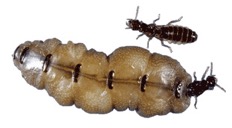
termite queen (bottom) and its king
Queen/s:
There is usually one main (first-form) queen who may have been the original founder of the colony. She may be larger than other colony members and swollen with eggs. Queens can live and reproduce for a long time (up to 20 years in some species). There may also be several supplementary queens in a colony, which can take over egg production from the primary queen when she dies.
King:
The original king fertilises the queen and helps to tend the young during the foundation of the colony.
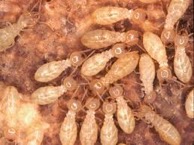
Workers
Workers are the only termite members that damage our wooden structures by feeding on them. They are responsible for all labours in a colony. They take care of young termites, repair nest, build foraging tunnel, locate food, and feed other members including the Queen and King of a colony. Like soldiers, workers are also sterile and blind. They usually make up more than 80 of a colony population. They lack eyes and wings. They are greyish white in colour.

Soldiers:
Are also wingless and resemble workers except that they have large, rectangular, yellowish and brown heads with large mandibles (jaws). The sole purpose of the soldier is to defend the colony against enemies such as ants . They are sometimes larger than workers. Two body forms are possible, with a particular species having one or the other: mandibulate (fully-jawed) and nasute (long-nosed). Some species also have two size classes - major and minor soldiers

Reproductive’s ( Alates):
Come in several forms, but you are most likely to see the winged, primary reproductives, which are commonly called swarmers. They are usually a brown-black to pale reddish-brown colour and about 1/4 to 3/8 inch long, with pale or smoke-gray wings. They can be confused with winged ants, but there are several distinct differences between them. A typical termite colony will have a single pair of reproductive’s (a "king" and "queen"). They remain in the nest and are fed by worker termites. Studies have shown that reproductive pairs can live 15-25 years.
Life Cycle and Habits
A mature queen can lay thousands of eggs each year. Workers tend these eggs during their two-week incubation period. The newly-emerged nymphs are fed regurgitated food by workers ("attendants"). After moulting, these new nymphs become members of the working caste, and eventually mature to become workers, soldiers, or reproductives.
As the colony grows, the workers expand the nest and their feeding area. Contrary to what was once believed to be true, a termite colony does not usually occupy a single large underground nest. As the foraging area expands the colony will split into a number of small "nesting sites". Studies have shown that a mature colony will contain 200,000 to 2,000,000 workers, although many colonies may contain as few as 50,000-60,000. A single acre of land may be supporting as many as 12 termite colonies (although this doesn't mean they are invading your home).
Termite colonies usually mature in about 3-6 years, at which time swarmers are produced. The swarmers leave the colony through "swarm castles". Swarming from a single colony usually occurs 3-6 years after the colony often occurs in several bursts that may take several days. The swarmers are poor fliers and usually move only a few yards from their emergence spo. After dropping to the ground, they shed their wings. Surviving males and females find compatible mates, and then burrow into the ground to become kings and queens of their own new colony. In some instances, a new colony forms from secondary reproductive’s who may not swarm and simply move out to form their own colony.
Workers need a high humidity to survive. Unlike ants, they do not forage out in open areas. Instead, they carry soil above ground where they construct mud tubes ( "Signs of a Termite Infestation") onto surfaces and into the wood where they are feeding to maintain a high relative humidity and to protect them from predators as they forage. Termites can also move their colony up and down in the soil to find the optimal temperature and moisture conditions.
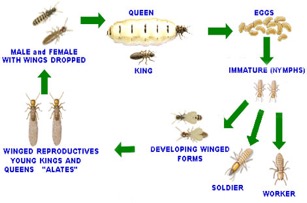
Termite Feeding Habits
Although termites feed on wood, they actually rely on microscopic organisms called protozoa in their gut to digest the cellulose, the basic component of wood. Colony workers who forage for food bring it back to the nest where they secrete material from their mouths and anuses to feed the reproductives, soldiers and newly-hatched nymphs.
What’s the difference between a termite and ant alate?
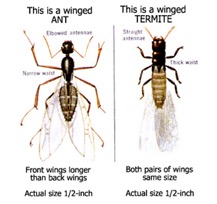
The alate is simply the adult, sexually mature stage in the ant or termite life cycle. Alates develop in the colony from immature stages prior to the flight season. When the alates receive the proper cues (warm temperatures, bright sunlight, low winds, for example) they will leave the colony and flyaway to start their own colonies. Male and female termites shed their wings and will pair up when a suitable mate is found. Then they will search for a suitably damp piece of wood or soil where they will start their new
colony.
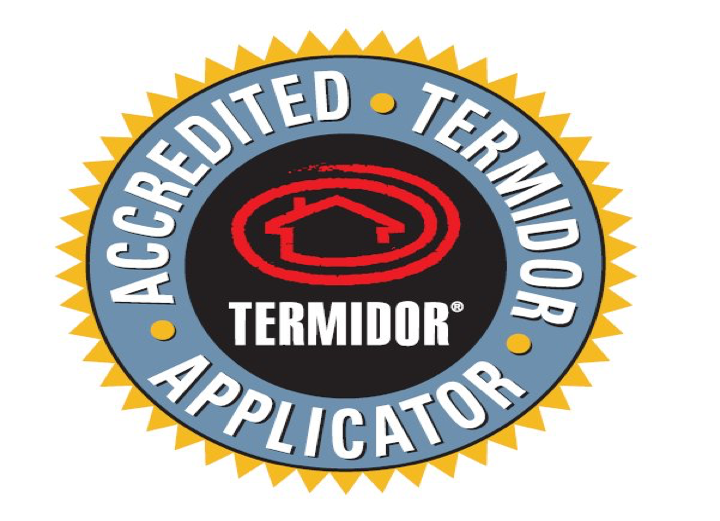
Specialised Experts in Termite Control, Termite Inspection, Termite Barrier, Termite Protection, Termite Removal, Termite Treatment Pre Construction Body Corporate in Melbourne ,Ballarat and Geelong – Redknight Termite & Pest Control
Call us now 1800 70 90 88 Camy.
